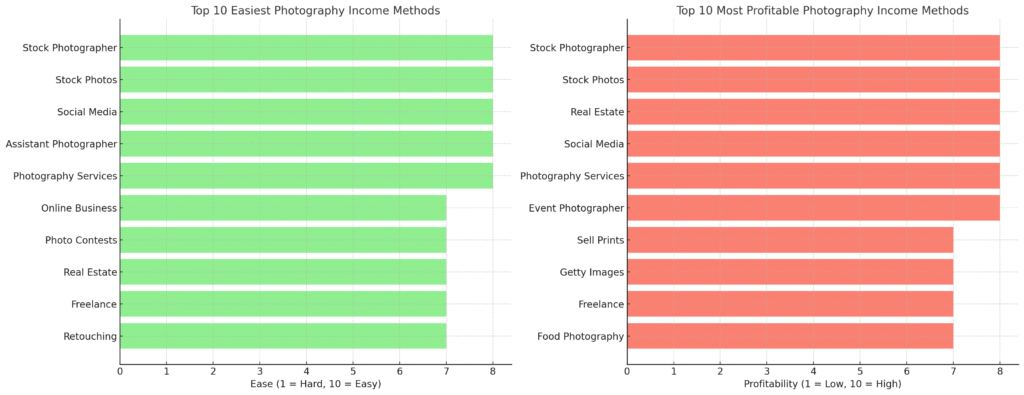
Have you ever asked yourself, “How can I make money with my photography?” Is it something possible? The answer is a resounding yes. With dedication, the right tools, and a clear plan, turning your passion for photography into a profitable venture is achievable.
Requirements Needed as a Beginner
Before diving into the various avenues to monetize your photography, it’s essential to have certain basics in place:
- Camera and Equipment: Invest in a reliable camera, preferably a DSLR or mirrorless model. Essential accessories include lenses, a tripod, memory cards, and a camera bag.
- Editing Software: Familiarize yourself with photo editing tools like Adobe Lightroom or Photoshop. These are crucial for post-processing your images.
- Portfolio: Create a collection of your best work to showcase your skills to potential clients or platforms.
- Online Presence: Establish a website or social media profiles to display your portfolio and attract clients.
- Legal Considerations: Understand the basics of running a business, including obtaining necessary licenses or permits and understanding copyright laws.
Related Articles
How Can I Make Money with My Photography?
There are numerous ways to monetize your photography skills. Here are some avenues to consider:
Here are two focused charts:
- Left: The top 10 easiest ways for beginners to start making money with photography.
- Right: The top 10 most profitable methods based on beginner-friendly potential.
This should help you decide where to start based on your comfort level and income goals.

1. Sell Prints
- Build a portfolio of your best photos, landscapes, portraits, or abstract shots that people might want on their walls.
- Use platforms like Etsy, Shopify, or your own website to sell prints.
- Work with a printing partner or use print-on-demand services (e.g., Printful).
- Promote your prints on social media and with friends/family.
- Offer framed or canvas options to attract different buyers.
2. Enter Photo Contests
- Search for beginner-friendly contests online (like ViewBug, GuruShots, or National Geographic contests).
- Read all rules and entry requirements.
- Submit your best work, making sure it fits the theme.
- Share your entry online to boost your chances (some contests use voting).
- Even if you don’t win, learn from the experience and try again.
3. Sell Photos to Magazines
- Identify magazines that match your niche, nature, travel, fashion, etc.
- Study their photography style.
- Email editors with a short pitch and a few sample images.
- If accepted, follow their submission guidelines closely.
- Keep track of what sells and build a relationship with editors.
4. Sell Stock Photos
- Sign up on websites like Shutterstock, Adobe Stock, or iStock.
- Upload high-quality images with good keywords and titles.
- Focus on themes that are always in demand people working, nature, food, technology.
- Be consistent, upload new content regularly.
- Check analytics to see what performs best.
5. Host Photography Workshops
- Choose a topic you’re confident in, beginner basics, portraits, or editing.
- Pick a location or set up a Zoom class.
- Advertise on Facebook, Eventbrite, or with posters locally.
- Set a price and include hands-on practice.
- Gather feedback and improve each time.
6. Create a Photography Blog
- Pick a blogging platform (WordPress, Blogger).
- Choose a niche, camera reviews, tips, behind-the-scenes.
- Post regularly and use SEO (keywords) so people can find you.
- Monetize through ads, affiliate links, or digital products.
- Share your blog on social media for more traffic.
7. Photograph Businesses
- Visit or contact local businesses like cafés, gyms, or boutiques.
- Offer to take product or branding photos.
- Show them a small portfolio to prove your skill.
- Deliver high-quality images and follow up for repeat business.
- Ask for testimonials and referrals.
8. Teach Photography
- Decide on your teaching format, 1-on-1, group class, or online.
- Plan out a beginner’s course (topics like exposure, composition, lighting).
- Create lesson materials or slides.
- Advertise through social media or photography forums.
- Start small and improve with feedback.
9. Become an Assistant Photographer
- Find local photographers and reach out to them professionally.
- Offer to assist for free or low pay to gain experience.
- Learn how shoots are run and take notes.
- Use this to build your network and improve your own skills.
- Gradually start taking on your own small jobs.
10. Become an Event Photographer
- Start with small events, family birthdays, local festivals.
- Offer discounts for your first few gigs.
- Be punctual, polite, and professional.
- Build a strong portfolio and ask for referrals.
- Expand to weddings, corporate events, and concerts.
11. Blog
(Same as #6 – Just ensure you’re writing regularly and sharing useful tips.)
12. Getty Images
- Apply to be a contributor on Getty Images.
- Submit 3–5 photos for review.
- If approved, start uploading regularly.
- Use proper tagging and metadata.
- Track your sales and stay on trend with Getty’s demands.
13. Online Business
- Choose what to sell, prints, presets, courses, digital downloads.
- Set up an online store (Shopify, Gumroad, Etsy).
- Write strong product descriptions.
- Promote your store using Instagram or Pinterest.
- Provide excellent customer service.
14. Photography Services
- Pick your niche, portraits, family sessions, pets, etc.
- Create packages with pricing.
- Promote locally and online.
- Take bookings and deliver on promises.
- Ask for reviews to build trust.
15. Retouching
- Learn photo editing deeply (Lightroom, Photoshop).
- Offer your service to photographers or businesses.
- Set up a Fiverr or Upwork profile.
- Show before-and-after examples.
- Deliver edits on time and professionally.
16. Organize Photography Tours
- Choose a scenic or interesting location.
- Plan a tour that includes stops, tips, and training.
- Set a price and create a registration page.
- Partner with local travel agencies or guides.
- Promote the tour online and offline.
17. Selling Books
- Choose a topic, your photo journey, a guide, or a themed photo book.
- Use tools like Canva or Blurb to design it.
- Self-publish on Amazon or sell through your site.
- Promote on YouTube, Instagram, and your email list.
- Collect feedback and improve future editions.
18. Social Media
- Pick 1–2 platforms (Instagram, TikTok, Pinterest).
- Post consistently, behind-the-scenes, tips, final edits.
- Use relevant hashtags to get discovered.
- Collaborate with brands and influencers.
- Monetize with affiliate links, promotions, or your own products.
19. Become a Food Photographer
- Practice by shooting food at home in good lighting.
- Build a food-only portfolio.
- Reach out to local cafés and restaurants.
- Offer free shoots for testimonials or social media tags.
- Specialize and start charging as you grow.
20. Concerts
- Attend local gigs and ask organizers for permission to shoot.
- Start with free shoots and share with the bands.
- Post online and tag the artists.
- Reach out to magazines or blogs that cover music.
- Offer paid packages to bands and promoters.
21. Freelance
- Create a strong online portfolio.
- Join freelancing platforms like Upwork, Fiverr, or Freelancer.
- Pitch your services clearly.
- Deliver quality work and ask for 5-star reviews.
- Build long-term client relationships.
22. Real Estate Photography Services
- Learn how to photograph homes (wide lenses, HDR, staging tips).
- Contact local real estate agents.
- Offer your services with a few free samples.
- Deliver photos fast, real estate moves quickly.
- Add drone shots or 360 virtual tours to stand out.
23. Become a Stock Photographer
(Same as #4 – Keep uploading consistently and follow market trends.)
24. Edit Photos
- Build editing skills and create samples.
- Offer services on Fiverr or freelance sites.
- Include options like color correction, retouching, or special effects.
- Show your process or transformations on social media.
- Deliver high-quality files in the right format.
Limitations
While there are many opportunities, be aware of potential challenges:
- Market Saturation: The photography industry is competitive. Standing out requires unique work and marketing.
- Initial Investment: Quality equipment and software can be expensive.
- Inconsistent Income: Especially when starting, income may fluctuate.
- Time Commitment: Building a client base and reputation takes time and effort.
How To Make Money with Photography Locally
Focusing on your local community can be beneficial:
- Network: Attend local events or join photography clubs to meet potential clients.
- Collaborate: Partner with local businesses for mutual promotion.
- Advertise: Use local newspapers, bulletin boards, or social media groups to advertise your services.
- Offer Promotions: Provide discounts or packages to attract local clients.
Conclusion
Making money with your photography is 100% possible. You’ve just seen over 20 proven ways to turn your camera into cash, even as a beginner.
Start small. Choose 1 or 2 methods that match your skills and interests. Focus, improve, and stay consistent.
Every pro started where you are. The only difference? They took the first step.
Now it’s your turn. Grab your camera and start.






